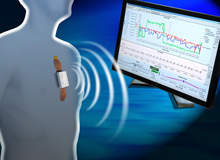
The rate at which technology is developing for healthcare has probably never been greater but it has come at a time when the financial crisis is putting pressure on health departments and, just as importantly, on the necessary research to bring these technical advancements to fruition. Research budgets are still relatively small compared with the costs of running healthcare in general and if the research can produce developments that make healthcare more affordable then there is money available.
Healthcare bodies are taking a leaf out of the military book in looking for existing projects in the commercial world that can be adapted to healthcare. For a long time now the military has followed what it calls the commercial off-the-shelf technology (COTS) route, finding it is cheaper to adapt existing commercial products than pay high prices for developing custom systems. Developers of products for healthcare are starting to do the same.
According to ST Microelectronics research and innovations director Maria Teresa Gatti, there have been huge improvements in technology in all sectors, from automotive to communications, and medical device producers are now learning from their success stories. An obvious example of this, says Gatti, are micro-electromechanical systems sensors that have been used widely for consumer devices such as portable music players and gaming stations and are now being adapted for use in healthcare for implantable and on-body sensors.
There are other high-profile examples of how COTS is entering the medical field. Take, for instance, the trial taking place at the Mayo Clinic in Minnesota in the US. Researchers are testing a platform for remotely monitoring patients with chronic cardiovascular disease. The main technology partner is ST Microelectronics, which is developing a wearable system that can measure all of a patient’s vital signs.
“We have sensors on the body and use a mobile phone for the gateway,” Gatti says. “You can transmit the data directly out of the patient’s chest onto the mobile phone. And we have developed a server to give the doctors access to what is happening.”
See Also:
The system is undergoing clinical trials but the hope is that next year the technology will be mature enough to be used in an environment where patients can use it at home.
How well do you really know your competitors?
Access the most comprehensive Company Profiles on the market, powered by GlobalData. Save hours of research. Gain competitive edge.

Thank you!
Your download email will arrive shortly
Not ready to buy yet? Download a free sample
We are confident about the unique quality of our Company Profiles. However, we want you to make the most beneficial decision for your business, so we offer a free sample that you can download by submitting the below form
By GlobalDataAt the moment such systems are easy to manage from the medical side as there are few patients using them. However, once trials have finished and the technology is rolled out to large numbers of patients, medical and technology teams will have to find ways of dealing with the vast amount of data the systems collect.
It is no surprise that companies are working long and hard to configure ways to manage data, and put it to use in the best way possible. Automation here is key for a lot of the processes, as well as usability for medical staff and patients.
The remote approach
Eventually, such automation will be able to help massively in the area of remote monitoring, away from the hospital. Technologists are developing more and more ways to allow people to be cared for in the home – opening up hospital beds and driving efficiencies in cash-strapped hospital wards.
Tremendous advances in mobile communications over the past decade, according to IT company MindTree‘s vice-president for R&D services Sridha Perepa, have meant home help can really be brought into its own. “[This means] at the patient end you can have low-cost devices that can be linked to a box and sent out over a network,” Perepa says.
“Internet technology is important here. You also need to store the data and make the information accessible to the doctors.”
The first part of this is transferring the information from the sensors to some kind of box, and here again commercial technology already has the answers. There are now various wireless protocols from Bluetooth to Zigbee that can cater for such demand, leaving researchers with the job of adapting these to make them more suitable for medical applications.
At the moment, all that is needed at both ends to ensure the data transferral is a high-end mobile phone. This has led developers to focus on applications that can be run on a mobile with the data being sent mobile phone networks. For higher data levels, notebooks may be used.
The Continua health alliance is looking at standardising the different ways that such systems can be run.
“Each manufacturer has its own standards for sending the data from these devices,” Perepa adds. “Continua wants to make the data uniform, so if you buy the equipment from any company it can be hooked up to a cell phone or PC to give the same response.”
Some of these devices are starting to filter through to the market and Perepa believes this will increase next year. For example, there are already wireless devices for measuring temperature, pulse rate and oxygen in the blood. Similar wireless sensors for handling blood glucose levels and blood pressure are likely to be released soon, he says.
Commercial communications technology can also be valuable for the emergency and rescue services. Data collected at the scene of an accident and in the ambulance on the way back to the hospital can be transmitted directly to medical staff waiting in emergency, saving valuable time.
IT vendor Congatec marketing manager Christian Eder says even images can be sent back, further saving time and streamlining processes.
Changing attitudes to IT
The only problem is the high cost of getting the work approved for medical use. In the US, companies are finding this particularly cumbersome and expensive. “We are seeing R&D dollars being spent beefing up the certification system for US Food and Drug Administration (FDA) approval,” says John Greenland, vice-president of business development at software company LDRA. “Our medical device customers have to be massively focused on FDA approval.”
Greenland says this was becoming even more difficult with the FDA becoming much more proactive to how it regulates technology. “The FDA realises these are safety critical and people could die,” he explains. “This means developers have to put new systems into place. They need more testing, more documentation, more processes. A lot of these guys had a fairly ad hoc system and now they are having to move to a more formal development system. It is diverting R&D money into the processes rather than the products themselves.”
This is making it harder for smaller companies to become involved in healthcare just at the time when the exploitation of commercial technology is opening the way for start-ups to enter the market.
As a result larger companies are scouting the market looking for the good ideas and then buying the patents or the companies themselves while a number of companies are looking to enter the healthcare market in the Far East where the qualification process is less strict before they enter western markets. Once a technology has become established in that part of the world, the money would then be available to take it through the more strict qualification processes in Europe and North America.
With such broad benefits to be derived, however, and data becoming even more valuable in the health chain, it is a path that is going to be trodden at some point in time. For those who innovate now, like with all technologies, the business benefits and lives saved will certainly outweigh the cost of changing medical attitudes to IT.





